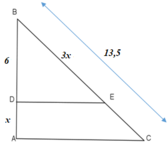Hãy nhập câu hỏi của bạn vào đây, nếu là tài khoản VIP, bạn sẽ được ưu tiên trả lời.

a) x = 1
b) x = 6; x = -3
c) x = 5,5; x = 1,5
d) x = 1; x = -1
e) x = -2; x = -1,000000371....

c)(x2+x)2-2(x2+x)-15
đặt x2+x=a ta có
a2-2a-15
=a2+3a-5a-15
=(a2+3a)-(5a+15)
=a(a+3)-5(a+3)
=(a+3)(a-5)
thay a=x2+x
(x2+x+3)(x2+x-5)

Phần I
Câu 1: c,d
Câu 2: e
Phần II
Câu 1:
a, 2008a2-2008b2=2008(a2-b2)=2008(a-b)(a+b)
b, x2-8x+15=x2-3x-5x-+15=x(x-3)-5(x-3)=(x-5)(x-3)
Câu 2:
a, M= (x-3)(x+3)-(x+2)2-2(x2-4,5)
M= x2-9-(x2+4x+4)-2x2+9
M= x2-9-x2-4x-4-2x2+9
M= -2x2-4x-4
M= -2(x2+2x+2)b, Để M=0 -> -2(x2+2x+2)=0->x2+2x+2=0
Phần 1:
Câu 1: D
Câu 2: E
Phần 2:
Câu 1:
\(A=2008a^2-2008b^2\)
\(=2008\left(a^2-b^2\right)\)
\(=2008\left(a-b\right)\left(a+b\right)\)
\(B=x^2-8x+15\)
\(=x^2-3x-5x+15\)
\(=x\left(x-3\right)-5\left(x-3\right)\)
\(=\left(x-3\right)\left(x-5\right)\)
Câu 2:
\(M=\left(x-3\right)\left(x+3\right)-\left(x+2\right)^2-2\left(x^2-4,5\right)\)
\(=x^2-9-x^2-4x-4-2x^2+9\)
\(=-2x^2-4x-4\)
\(=-2\left(x^2+2x+2\right)\)
\(=-2\left[\left(x^2+2x+1\right)+1\right]\)
\(=-2\left[\left(x+1\right)^2+1\right]\)
\(=-2-2\left(x+1\right)^2\le-2< 0\)
Vậy không có giá trị nào của x thoả mãn yêu cầu.

\(\Leftrightarrow A=\left(\dfrac{x}{x+2}+\dfrac{\left(x-2\right)\left(x^2+2x+4\right)}{\left(x+2\right)\left(x^2-2x+4\right)}.\dfrac{\left(x-2\right)^2}{-\left(x-2\right)\left(x+2\right)}\right):\dfrac{4}{x+2}\)
\(\Leftrightarrow A=\left(\dfrac{x}{x+2}-\dfrac{\left(x-2\right)\left(x+2\right)^2}{\left(x+2\right)\left(x-2\right)^2}.\dfrac{-\left(x-2\right)}{\left(x+2\right)}\right):\dfrac{4}{x+2}\)
\(\Leftrightarrow A=\left(\dfrac{x}{x+2}-1\right):\dfrac{4}{x+2}\)
\(\Leftrightarrow A=\dfrac{2}{x+2}:\dfrac{4}{x+2}\)
\(\Leftrightarrow A=\dfrac{1}{2}\)
\(A=\left(\dfrac{x}{x+2}+\dfrac{x^3-8}{x^3+8}.\dfrac{x^2-2x+4}{4-x^2}\right):\dfrac{4}{x+2}=\left(\dfrac{x}{x+2}+\dfrac{\left(x-2\right)\left(x^2+2x+4\right)}{\left(x+2\right)\left(x^2-2x+4\right)}.\dfrac{x^2-2x+4}{-\left(x-2\right)\left(2+x\right)}\right).\dfrac{x+2}{4}=\left(\dfrac{x\left(x+2\right)}{\left(x+2\right)^2}-\dfrac{\left(x^2+2x+4\right)}{\left(x+2\right)^2}\right).\dfrac{x+2}{4}=\left(\dfrac{x^2+2x-x^2-2x-4}{\left(x+2\right)^2}\right).\dfrac{x+2}{4}=\dfrac{-4}{\left(x+2\right)^2}.\dfrac{x+2}{4}=-\dfrac{1}{x+2}\)

Người thấy khó thì thấy nhiều![]()
![]()
Người thấy dễ thì thấy bình thường hoặc kể cả dễ ẹc![]()
![]()
![]()
Khổ nổi em chưa học tới thông cảm nha![]()

a, \(t\left(t+2a^2\right)+a^4=t^2+2a^2t+a^4=\left(a^2+t\right)^2\)
b, \(x^2+3x+2=x^2+2x+x+2=x\left(x+2\right)+\left(x+2\right)\)
\(=\left(x+1\right)\left(x+2\right)\)
c, \(x^4+5x^3+9x^2+7x+2\)
\(=x^4+x^3+4x^3+4x^2+5x^2+5x+2x+2\)
\(=x^3\left(x+1\right)+4x^2\left(x+1\right)+5x\left(x+1\right)+2\left(x+1\right)\)
\(=\left(x^3+4x^2+5x+2\right)\left(x+1\right)\)
\(=\left(x^3+x^2+3x^2+3x+2x+2\right)\left(x+1\right)\)
\(=\left[x^2\left(x+1\right)+3x\left(x+1\right)+2\left(x+1\right)\right]\left(x+1\right)\)
\(=\left(x^2+3x+2\right)\left(x+1\right)^2\)
\(=\left(x+2\right)\left(x+1\right)^3\)

Answer:
Câu 1:
\(\left(5x-x-\frac{1}{2}\right)2x\)
\(=\left(4x-\frac{1}{2}\right)2x\)
\(=4x.2x-\frac{1}{2}.2x\)
\(=8x^2-x\)
\(\left(x^3+4x^2+3x+12\right)\left(x+4\right)\)
\(=x\left(x^3+4x^2+3x+12\right)+4\left(x^3+4x^2+3x+12\right)\)
\(=x^4+4x^3+3x^2+12x+4x^3+16x^2+12x+48\)
\(=x^4+\left(4x^3+4x^3\right)+\left(3x^2+16x^2\right)+\left(12x+12x\right)+48\)
\(=x^4+8x^3+19x^2+24x+48\)
Ta thay \(x=99\) vào phân thức \(\frac{x^2+1}{x-1}\): \(\frac{\left(99\right)^2+1}{99-1}=\frac{9802}{98}=\frac{4901}{49}\)
Ta thay \(x=4\) vào phân thức \(\frac{x^2-x}{2\left(x-1\right)}\) : \(\frac{4^2-4}{2.\left(4-1\right)}=\frac{12}{6}=2\)
\(\left(x+y\right)^2-\left(x-y\right)^2\)
\(= (x²+2xy+y²)-(x²-2xy+y²)\)
\(= x²+2xy+y²-x²+2xy-y²\)
\(= 4xy\)
\(4x^2+4x+1=\left(2x+1\right)^2=\left(2.2+1\right)^2=25\)
Câu 2:
\(x^2+x=0\)
\(\Rightarrow x\left(x+1\right)=0\)
\(\Rightarrow\orbr{\begin{cases}x=0\\x+1=0\end{cases}}\Rightarrow\orbr{\begin{cases}x=0\\x=-1\end{cases}}\)
\(x^2.\left(x-1\right)+4-4x=0\)
\(\Rightarrow x^2.\left(x-1\right)+4\left(1-x\right)=0\)
\(\Rightarrow\left(x-1\right)\left(x^2-4\right)=0\)
\(\Rightarrow\left(x-1\right)\left(x-2\right)\left(x+2\right)=0\)
Trường hợp 1: \(x-1=0\Rightarrow x=1\)
Trường hợp 2: \(x-2=0\Rightarrow x=2\)
Trường hợp 3: \(x+2=0\Rightarrow x=-2\)
Câu 3: Bạn xem lại đề bài nhé.

Ta có: ED ⊥ AB, AC ⊥ AB => DE // AC (từ vuông góc đến song song), áp dụng định lý Talet, ta có: B D D A = B E E C
⇔ x 2 + 6 x – 27 = 0
Vậy x = 3
Đáp án: A